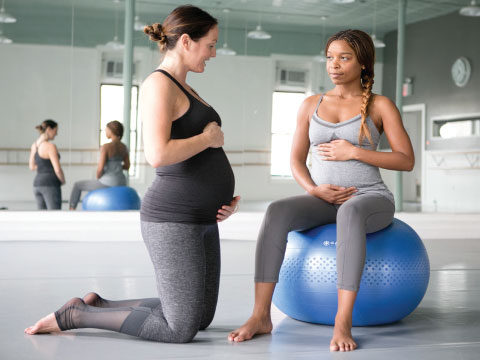Expectant moms would probably not be strangers to the fact that exercising does wonders for a pregnancy. Moderate workouts help improve sleep and reduces aches and pains and when carried out diligently, helps to keep one in a good mood too, while paving the way for better postnatal recovery and health.
It’s important though, to be extra cautious during your workouts when you’re pregnant. Following these 10 rules will keep you and your baby healthy, safe and in great shape!
1. Get your doctor’s approval
Regardless of whether you’ve been exercising regularly before pregnancy or not, being pregnant calls for a doctor’s approval when it comes to things like exercising — or more accurately, the intensity of the exercises you intend to perform.
This is because in some cases exercising may be prohibited or will have to be limited due to a certain condition. So talk to your doctor about your intended fitness routine to make sure your activities don’t put you or your baby at risk.
2. Make do with the safest activities
Walking, swimming, aerobics and dancing are the safest cardio exercises for pregnant moms, where else supervised yoga are best for flexibility and strength. Avoid exercises that involve lots of contact as well as activities that might throw you off balance and cause a fall, such as horseback riding, surfing or gymnastics.
Cycling early in your pregnancy should be safe if you’re already comfortable on a bike, but it’s probably best to stick to stationary bikes later in pregnancy to avoid accidents due to losing your balance.
3. Warm up!
Warming up prepares your muscles and joints for exercise and increases your heart rate slowly. Regardless if you’re pregnant or not, if you skip the warm-up and jump into exercise moves before your body is ready, you could strain your muscles and ligaments and have more aches and pains after your workout.
A good way to warm up is to start your chosen activity at a low intensity and slowly increase it during the first five to eight minutes.
4. Cool down
At the end of your workout, walk in place for five to 10 minutes and perform some light stretching. This improves your flexibility while getting your heart rate back to normal. Stretching also prevents sore muscles.
5. Eat well
Exercise burns calories, so be sure to eat well to nourish and strengthen your body. When you’re pregnant, you naturally gain weight as your baby grows. The amount you need to gain varies based on your pre-pregnancy weight. When regular exercises are in the picture, you may even need to eat a little more depending on your exercise routine.
If you’re underweight or overweight, you may need to gain a little more or less than someone with a healthy BMI and adjust your calorie intake accordingly. This is where your doctor can help, by monitoring your weight as your pregnancy progresses and helping you keep track of your overall health.
6. Drink up!
Keep your drink of water on standby and sip on it before, during, and after exercising to avoid dehydration. This is important for dehydration during pregnancy can set off a chain of reactions in your body that leads to a reduced of amount of blood reaching the placenta.
Dehydration can also increase your risk of overheating or even trigger contractions. There’s no official recommendation for how much water pregnant women should drink while exercising, but many experts recommend a simple technique to gauge whether you’re drinking enough: Check the color of your urine.
Dark yellow urine is a sign of dehydration. If that’s the case for you, have one or two glasses of water every hour until your urine is pale yellow or nearly clear.
7. Wear suitable clothing
Wear comfortable, moderately loose clothing that are layered to make it easier to peel of if your feel too warm.
Don’t forget to wear a comfortable and supportive bra too as well as a well-fitting, comfy pair of sneakers — you may need a bigger pair than your normal shoes due to possible swelling. Add good gel liners to your workout sneakers for added comfort and to absorb shock better.
8. Don’t lie on your back
After the first trimester, avoid exercising while lying flat on your back. The weight of your uterus puts pressure on a major vein called the vena cava, which can reduce blood flow to your heart and may diminish blood flow to your brain and uterus.
This can make you dizzy, short of breath, or nauseated. Try propping up your upper body with pillows while you exercise, for this enables you to be almost flat on your back without compressing the vena cava.
9. Watch that you don’t overheat
During pregnancy, the increased blood flow will make you feel warmer than usual, especially when you exercise. Also, pregnancy makes it harder for your body to regulate its temperature and disperse heat like it normally does.
As a result, you may get overheated much faster than you normally would! That’s why it’s especially important to avoid exercising in hot or humid conditions during pregnancy. Signs of being overheated are largely individual, but pay attention if you’re sweating a lot or feel uncomfortably warm, nauseated, dizzy, or short of breath.
To cool off quickly, stop exercising, take off layers, and change your environment: Go someplace with air-conditioning or step into a cool shower.
10. Know your limit
Avoid getting exhausted from exercising. If you find yourself having trouble in carrying on a conversation comfortably, it’s your body’s way of telling you to slow down. Exercising is to strengthen your body and give it more flexibility, not punish it with exertion.
Stop immediately if your body begins to hurt — remember, you’re pregnant! After exercising, try to rest for an equivalent amount of time before getting on with your day. For example, if you’ve just jogged for 30 minutes, rest quietly for 30 minutes.




















